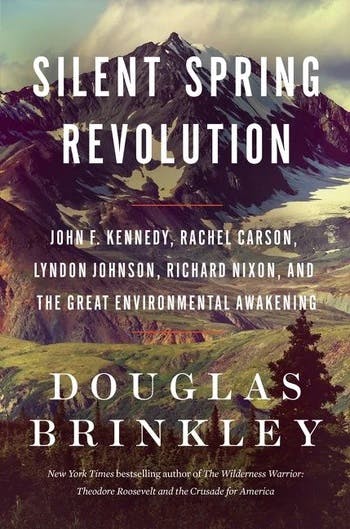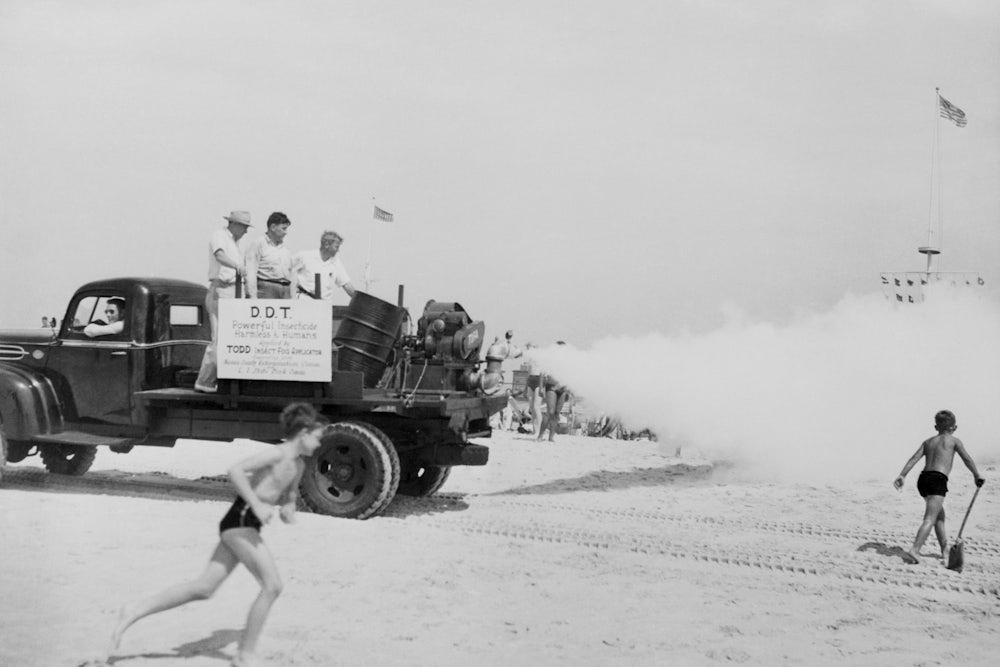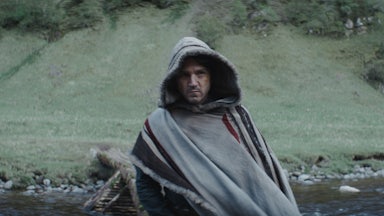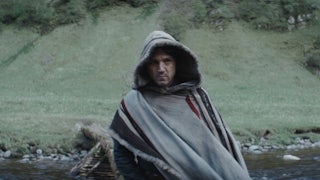If you have glanced at the news—or stepped outside—in recent years, the ravages of climate change have been hard to ignore. From colossal flooding in Pakistan to unprecedented heat waves in China, even to the rapid proliferation of spotted lanternflies across the United States, the consequences of a changing climate have come into terrifying focus in recent months. As he drafted his most recent book, the historian Douglas Brinkley lamented the signs around him. On television, he could see images of forest fires in Yosemite; outside his window was the brutal 110-degree Texas heat. “This is the new normal,” Brinkley typed, “courtesy of our nation’s—indeed, the world’s, addiction to fossil fuels.”
It is surprising then that Brinkley is sanguine about the accomplishments and future of the environmental movement. His sweeping new history of environmentalism in the U.S. in the 1960s and early 1970s, Silent Spring Revolution: John F. Kennedy, Rachel Carson, Lyndon Johnson, Richard Nixon, and the Great Environmental Awakening, is an avowedly optimistic book. “I consider Silent Spring Revolution to be a ‘hope machine,’” Brinkley writes, borrowing a term from folk singer Woody Guthrie, “reminding readers that our own times aren’t uniquely oppressive and that everyday people and nonprofit groups retain the capacity to fight for a green tomorrow in the United States and around the world.” His lesson is that people—by convincing a powerful and prominent few to roll up their sleeves, reach across the aisle, and act on their better angels—can effectively safeguard clean water, fresh air, and healthy green space.

Brinkley’s three previous books on this theme lay the groundwork for a story of uplift. Silent Spring Revolution is the fourth in a monumental series, collectively exceeding 3,000 pages in length, that he has named his “Wilderness Cycle.” Together, the books masterfully link beloved twentieth-century presidents (Roosevelt, Roosevelt, and Kennedy) with waves of environmental progress: Theodore Roosevelt and the conservation of hundreds of millions of acres of “wild” lands in the early twentieth century; FDR and the expansion of federal control over extractive industries and ecological protection in the Depression and World War II; and JFK and the explosion of a mass environmental movement in the postwar years, especially the Long Sixties.
Brinkley had originally planned to end the story in 1964, with Rachel Carson’s death and Lyndon B. Johnson’s signature of the Wilderness Act. But in this final volume, he continues through the presidency of unlikely environmentalist Richard Nixon and the passage of the fully realized Endangered Species Act. The time frame enables Brinkley to recount all of the movement’s many successes and wrap up the tale just before the Reagan revolution struck back. It also allows him to paint not only Kennedy but also Johnson and Nixon as unheralded environmental heroes. The result is a narrative with few failures and fewer villains, with rhetorical allusions to populist environmentalism but with a perspective so tightly, even lovingly, focused on those in power that Brinkley can write without irony that “the culminating event of the Long Sixties ecology zeitgeist” was not Earth Day, nor any of the era’s iconic and creative protests, but the signature of the National Environmental Policy Act.
One of the most celebrated American historians working today, Brinkley brings considerable authority to the project: He holds a chaired professorship at Rice University, has written over a dozen books, and even won a Grammy. Silent Spring Revolution, which draws on years of research in presidential libraries and dozens of interviews, is sure to be mined by environmental and presidential historians for years to come. It is deeply researched, sensibly structured, and possessed of a fundamentally impoverished view of environmental history.
Brinkley begins his account with the activism against the nuclear bomb. The obliteration of two Japanese cities (and hundreds of thousands of lives) was literally a world-altering event, spurring the young U.S. Senator John F. Kennedy to tell friends “that world history would be forever divided into two epochal categories: before and after Hiroshima.” Initially, just a prophetic few—including Supreme Court Justice William O. Douglas—cautioned that atomic weapons could have grave effects not only on humanity but on the environment. In the years that followed, more and more people made the connection, as scientific revelations about the dangers of radiation dovetailed with growing calls to end war, sowing the seeds for a truly mass movement.
In the late 1940s and early 1950s, the White House was occupied by Harry Truman, a president “disinterested in practically any regulatory stance that would stunt postwar US business growth,” Brinkley writes. He was followed by Dwight Eisenhower, whose insistence that pollution was a purely local matter matched Truman’s resistance to environmental oversight. But a young nature-lover from Massachusetts was growing in popularity, and soon he would transform old-fashioned conservationism into “environmentalism, linking together public health, the balance of nature, wildlife protection, and objections to nuclear testing.”
John F. Kennedy’s environmentalism emerged from his almost spiritual love of sailing in the waters bordering his family’s many homes, Brinkley argues. The sight of trash and pollution dirtying his beloved seashores sparked in him an ecological awareness that was nurtured by William O. Douglas, a family friend. By the time Kennedy ran for the presidency in 1960, he was pushing a bold conservation strategy “that built on the White House records of the two Roosevelts”: designating millions of new acres of protected wilderness and swelling the federal personnel to match.
Another environmentalist was preparing to change the world at this time—initially unaware, just like Kennedy, that she was fast approaching the end of her life. A “trim and proper” science writer, Rachel Carson was best known for her lyrical bestsellers about the fish and birds that lived within and above the seas. But by the late 1950s, she had begun hearing rumblings of concern that pesticides—especially the omnipresent DDT—might be causing profound health problems in animals and humans alike. Not long after she began to research this disturbing subject, Carson herself was diagnosed with cancer.
Brinkley tells the stories of President Kennedy’s eager environmental efforts and Carson’s desperate race to complete Silent Spring side by side, showing how the work of each relied on and grew out of the other’s. Kennedy’s push for pollution controls, new national parks and refuges, a nuclear test ban treaty, and a Wilderness Act (which would preserve large roadless areas forever) drew on the burgeoning movements against littering, pollution, and nuclear testing in which Carson had been active. Carson’s research on DDT was greatly aided by contacts within Kennedy’s orbit, including Douglas and Interior Secretary Stewart Udall. The increasingly weak Carson, in turn, served as Udall’s “conscience” on environmental matters. Her book led to a documentary, which led to congressional hearings, which emboldened the administration still further. When the chemical industry viciously attacked Carson and her findings, federal officials defended her. Kennedy’s own embrace of Silent Spring marked a “turning point” in the evolution of a national environmental movement. After Kennedy’s assassination late in 1963, Carson mourned his passing but “took solace from her association” with the late president. When she died the following year, Udall was one of her pallbearers. Reformers within and without the Kennedy White House had united to foment what Brinkley calls “Carson’s revolution.”
Lyndon B. Johnson, who had his own deep connection to the wild beauty of the Texas hinterlands, surprised many by building on this work, not only designating numerous new national parks but also muscling through the Wilderness Act, soon followed by a slew of anti-pollution measures, a Wild and Scenic Rivers Act, and an early version of the Endangered Species Act. In Brinkley’s assessment, Johnson even surpassed Kennedy’s environmental record, rivaled only by the Roosevelts. Yet the public turned against Johnson due to the seemingly endless Vietnam War, with environmentalists (noting that American napalm was defoliating Vietnam’s tropical ecosystems) as cutting as any others in their critiques.
Johnson chose not to run for reelection, and he was followed in the White House by Republican Richard Nixon. In spite of Nixon’s bottomless paranoia about environmentalists—he once dismissed them as “commie pinko queers”—he too embraced the movement, spurred in no small part by nationwide protests over oil spills and burning rivers (as well as, Brinkley posits, his personally witnessing the environmental degradation of Southern California). By the end of his presidency, Nixon had created the Environmental Protection Agency, banned DDT, and signed into law the Clean Water Act, Clean Air Act, two strengthened Endangered Species Acts, and the National Environmental Policy Act, the “foundation of US federal sustainability efforts well into the twenty-first century.”
Of course, the presidents could not have done all this alone, and Brinkley’s doorstop of a history is filled out by a cast of characters that includes Udall, a strapping Westerner whose love of the rugged outdoors Brinkley smartly ties to the Mormon ethic of land stewardship; Sierra Club president David Brower, a confrontational Californian who transformed the staid old hiking club into a political powerhouse; Lady Bird Johnson, who pushed hard for the “beautification” of roads and cityscapes across the country; and John Ehrlichman, a key Nixon adviser and shockingly passionate environmentalist. Together, this colorful constellation of power-players worked to do the right thing, the book concludes: “Democrats and Republicans boldly united to save the Great American Outdoors from further desecration.”
About two-thirds of the way through the book, Brinkley quotes William Ruckelshaus, the first administrator of the EPA: “None of these environmental historians get it right. They all want to write about the Sierra Club and the Wilderness Society because it’s romantic. But the story of the 1960s environmental movement should be centered on how Johnson and then Nixon launched an effective campaign for comprehensive sewage treatment in America.” (Brinkley adds: “What Ruckelshaus said was true.”) In other words, the credit for the “environmental movement” lies not with the activists but with the presidents.
There is a term for this approach to the past: the Great Man school of history, wherein the drivers of progress are not the masses but rather the generals, the titans of industry, the U.S. presidents. And so in Silent Spring Revolution, the early environmental justice movement boils down almost entirely to leaders like Martin Luther King Jr., Cesar Chavez, and Walter Reuther, rather than the millions of unsung civil rights organizers, farmworker activists, and union members who fought and bled and died for their causes. Brinkley attributes the rightward drift of the Supreme Court to “the triumph” of Southern tobacco lobbyist Lewis Powell in “reversing Douglas’s anti-industry” stance, with not a word about the conservative legal movement (or the mountain of money fueling it). Above all others, he makes Carson the book’s protagonist, heart, and sacred mother. “It was Rachel Carson, full stop, who, in an urgent visceral way, sparked an eco-revolution,” Brinkley tells us.
Carson’s influence should not be undercounted, but to credit her—full stop—with launching the environmental movement is wrong. Brinkley’s focus on the best-known (and, often, best-loved) figures in environmental history is, in fact, uniquely ill suited to explain fights to protect land, water, and air, which are necessarily movement-driven. He notes, at times, that activists pushed the presidents and other powerful figures—but we hardly ever meet these unfamous advocates. Bizarrely, Brinkley entirely fails to cite one of the most important works of environmental history to be published in recent years (and one highly relevant to his project), The Myth of Silent Spring: Rethinking the Origins of American Environmentalism by Chad Montrie, which compellingly argues that multiple, significant grassroots environmental movements arose largely independent of Carson’s influence.
By contrast, Brinkley’s approach flattens the movement to a march of saints who, inexplicably, must be safeguarded against critique or elision. Johnson “got it completely right about environmental stewardship,” Brinkley writes, but has “received scant credit for anything he did on the conservation front,” his successes “largely neglected” by scholars. Nixon—who is undoubtedly best known by most readers for his demons, his bigotry, and his career-ending scandals—in fact emerged quickly “as the Rough Rider of environmental activism,” Brinkley tells us, and ultimately became “an extraordinary environmental president.” It is these already-famous men who receive the great bulk of Brinkley’s attention and praise.
Indeed, this has been Brinkley’s formula for decades: Take a revered, powerful figure, claim that this figure has been cruelly maligned by the left and right, and then, with post-partisan aplomb, reassure the reader that, yes, the figure really was as great as you thought. In The Wilderness Warrior, Brinkley writes (absurdly) that Teddy Roosevelt’s environmentalism “has been unfairly minimized by scholars,” due in part to “a left-leaning bias against aristocratic hunters” such as “TR.” In Rightful Heritage, he writes that Franklin Roosevelt’s “conservation heroics” (the subject of multiple previous books) have been unfairly “overshadowed in history by TR” (at least, “up until this publication”). Wheels for the World, Brinkley’s history of the Ford Motor Company, includes a portrait of its then CEO, Bill Ford Jr., so flattering—“not just another run-of-the-mill executive,” but an environmentalist so “passionate” that he shocked “those many people prejudiced against the children of billionaires”—as to be embarrassing. In Silent Spring Revolution, Brinkley tells the reader that Robert F. Kennedy Jr. became “an environmental lawyer determined to save hawks and kestrels from DDT poisoning and habitat destruction,” yet completely fails to mention that Kennedy is best known today as a virulent anti-vaccine crusader.
His desire to shore up the powerful and avoid the contamination of partisan politics is especially damaging in Silent Spring Revolution, for it forces Brinkley to write an environmental history virtually without villains—and without an accurate accounting of the movement’s many failures.
“I’m not here to demonize the petroleum industry” or any of the federal agencies so criticized by Sixties-era activists, Brinkley writes in the book’s introduction. And, indeed, his nearly-900-page book features almost no corporate executives or anti-environmental agency staff. As a result, nearly everyone in his narrative (except the Colorado Congressman Wayne Aspinall) is depicted as earnestly dedicated to the cause of environmental protection. This makes for a dutiful march toward progress, inevitable and therefore at least a bit boring. It also completely elides a significant chunk of the environmental movement’s capture by industry and descent into transphobia and anti-immigrant vitriol.
At no point does the reader learn why anyone would oppose so righteous a movement—indeed, why so many did oppose it, and so successfully. Brinkley is up-front about the fact that he “largely skirt[s] the counterrevolution that emerged against Rachel Carson” and other environmentalists, attributing this decision to the fact that his account ends in 1974, just as the counterrevolution “arose with vengeance.” But the roots of that counterrevolution can be found in previous decades, in the businessmen’s war against the New Deal, in industry’s relentless fight for secrecy and against regulation, in segregation and every other tactic to safeguard the spoils of the few. The book concludes with the energy crisis and the election of Ronald Reagan, with the rise of the conservative movement and corporate leaders’ “full-fledged counteroffensive, attacking environmentalists as ‘mystics,’ ‘sentimental bird-watchers,’ ‘kooks,’ ‘hippies,’ and ‘alligator-freaks.’” But such forces appear to come out of nowhere, which they did not.
Brinkley set out to tell an optimistic history, but—to employ an ecological metaphor—this leads him to miss the forest for the trees. His is not an optimistic story—it’s one of failure. The absent industrialists won the war; pollution continued to accumulate to such an extent that virtually all of us have pesticides and even microplastics in our bodies, the world is hurtling toward climate apocalypse, and we are in the midst of an unthinkably destructive mass extinction. Environmental history should not be comfortable or enjoyable. The environmentalists lost.
Further, in focusing overwhelmingly on a handful of famous figures (nearly all men, other than Carson), Brinkley omits many of the most important and interesting (and, indeed, hopeful) facets of Sixties-era environmentalism. Other than brief, scattered mentions, we learn nothing about the fight against strip-mining and black lung; the fight for an “environmental bill of rights”; environmental unionism (beyond Walter Reuther’s United Auto Workers); the metastatic growth of suburbanization and freeways and car culture; the profound environmental damage of urban renewal and mass incarceration; Native American critiques of national parks (especially troubling because Brinkley notes, in an endnote, “a future book project on national parks”); the outsourcing of ecological harm to U.S. territories and holdings (including Puerto Rico, Guam, and the Marshall Islands); and the monstrous environmental effects of U.S. foreign policy (including structural adjustment, austerity, and their impacts on the developing world).
As the activist Chico Mendes remarked (shortly before a rancher, opposed to his efforts to save the Brazilian rain forest, orchestrated his assassination), “Environmentalism without class struggle is just gardening.”
Finally, and perhaps most fundamentally, Silent Spring Revolution is mistitled. Twentieth-century environmentalism yielded a great many valuable reforms, but it was not a revolutionary movement. The federal laws so lauded by Brinkley established a precautionary approach to pollution but did little to halt the forces that cause pollution in the first place. (And today, courts are neutering almost every one of these laws.) Had there been an actual revolution, we would have seen land redistribution and state seizure of utilities and energy resources, as happened in postcolonial nations throughout this time period. “Silent Spring had spawned a revolution,” Brinkley asserts. This is untrue. Carson, Kennedy, Johnson, and Nixon—among many, many others—did not lead a revolution; they won reforms, which were both vital and inadequate.
Among the oddest of Brinkley’s narrative decisions is his framing of several relationships that look, well, queer. In a passage about the fight against DDT, for instance, we are told that anti-pesticide pioneer Marjorie Spock lived on Long Island with her “friend,” Mary “Polly” Richards, but no more. This pointedly elides the reality of Spock and Richards’s relationship; the two cohabitated for decades, living together across multiple states in what looks quite like a Boston marriage, with Spock caring for Richards as exposure to pesticides worsened her chronic health conditions. (In her own recent book on DDT, the historian Elena Conis did not hesitate to identify Richards as Spock’s “partner.”) Ignoring the profoundly intimate nature of their relationship overlooks the powerful motivation of Spock’s activism: “It was to protect Polly,” Conis writes. In other words, Spock—who brought the first lawsuit seeking to halt the spraying of DDT on environmental grounds—was driven by love.
Even more strangely, Brinkley completely omits Carson’s own ardent, years-long relationships with women—a fact that has led many modern queer readers to claim her as one of their own. Consider Carson’s aching correspondence with Dorothy Freeman (only ever characterized by Brinkley as a neighbor and friend). Freeman: “I’ve wanted you so when I looked at the moon, when the tide was high; when the water made wild sounds in the night.” Carson: “Why do I keep your letters? Why did I come to the Head that last night? Why? Because I love you!” Perhaps seeking to obscure this relationship, as she was nearing death, Carson destroyed many of their letters.
Brinkley, in this very long book, finds time to discuss Udall redecorating the Interior Department building and Douglas’s many marriages; this omission feels deliberate. Speculating about the queerness of historical figures is, to be sure, a fraught endeavor, due to both the dearth of evidence and the imprecision of mapping our own understandings of queerness onto subjects who may have understood their relationships differently. But ignoring these relationships altogether risks dulling contemporary understandings of these figures, their lives, loves, and works.
To write hundreds of pages about Carson without so much as glancing at this part of her life is to overlook some of the most interesting implications of her environmental work. In a recent essay (not cited by Brinkley), the political scientist Lida Maxwell read Silent Spring in conjunction with Carson’s correspondence with Freeman, concluding not only that their love was “an important catalyst for Carson’s writing of Silent Spring” but also that Silent Spring itself must be understood “as a work of love: a work written not only on behalf of saving life from the dangers of pesticides and insecticides, but also on behalf of the human affects and pleasures (in particular, wonder and love) that are made possible by a vibrant multispecies world.” That is, to Carson it was imperative to eliminate pesticides not only to save lives but to save that which made life worth living—the connections among all living things.
Brinkley believes that Silent Spring “was written without gladness,” as Carson despaired at the destruction wrought by humans. Yet Maxwell reads its ecosystems-wide perspective as an expression of wonder and love. Both have a point. But Maxwell’s theory makes for more usable history. The movement today doesn’t need Brinkley’s groundless optimism. It needs Carson’s queer joy, the solidarity of understanding ourselves as just part of a grand system, the certainty of seeing environmentalism as a struggle against oppression. We fight for the world because we fight for each other.






